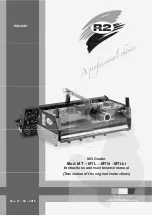
WR6K-OM-E Rev A
ISSUED: October 2003
347
DFP2 OPTION
INTRODUCTION
The Need
In today's complex environment, data is frequently composed of a mixture of analog and digital
components spread over a broad range of frequencies. In many applications, the relevant data is
encoded or obscured. Capturing the right signals becomes a challenge. Engineers find it
increasingly difficulty to examine only those parts of the data they are interested in. Traditional (or
even smart) oscilloscope triggering cannot always provide a satisfactory answer.
For example, servo motors from disk drives add a low frequency component to the high
frequency data output. It is hard to achieve an accurate analysis of data unless the low
component is removed.
Another common example is switched power supply units, which inject the switching frequency
component into many system parts. Viewing digital signals mixed with this switching frequency
component could be very difficult. Filtering is definitely required.
Yet another example is in ADSL residential connectivity, where data is transmitted over 256
narrow bands. Each band is only 4.7 kHz wide, and the gap between two adjacent bands is also
4.7 kHz. Examining such complex waveforms with regular DSOs is almost impossible; filtering out
unwanted frequency components is necessary.
The Solution
At present, these needs are addressed in two ways. One way is building analog filters and
placing them in front of the oscilloscope, providing an already filtered signal to the DSO. The
disadvantages of this approach are many. Analog filters depend heavily on the accuracy and
stability of analog components. Although in some cases analog filters are easily implemented,
they are quite impractical for low (< 100 Hz) or high (> 100 MHz) frequency ranges. In
comparison, digital filters can provide the desired results in those cases.
The second approach, practiced by many engineers, is using the DSO as a digitizer. The digitized
data output is then transferred to a PC for processing. This solution frequently provides the
required results, but it might be too slow or too limited in flexibility for some applications.
With Digital Filter Package 2 (DFP2), LeCroy provides a solution that combines the best of both
worlds. This package includes seven of the most useful finite impulse response filters (FIR), in
addition to a custom design feature. It also includes four infinite impulse response (IIR) filter types
(Butterworth, Chebyshev, Inverse Chebyshev, Bessel). You can easily set the Cutoff Frequency in
addition to the Stop Band Attenuation and Pass Band Ripple for each filter.
It is even possible to use single filters or multiple filters cascaded for even more complex filtering.
Once filtered, waveforms include mostly relevant frequency components, undesired parts being
greatly attenuated.
Summary of Contents for 6000 SERIES
Page 65: ...WR6K OM E Rev A ISSUED October 2003 63 Proper Orientation of Drive ...
Page 131: ...WR6K OM E Rev A ISSUED October 2003 129 Example ...
Page 141: ...WR6K OM E Rev A ISSUED October 2003 139 ...
Page 236: ...Operator s Manual 234 ISSUED October 2003 WR6K OM E Rev A Example 6 ...
Page 261: ...WR6K OM E Rev A ISSUED October 2003 259 ...
Page 286: ...Operator s Manual 284 ISSUED October 2003 WR6K OM E Rev A ...
Page 304: ...Operator s Manual 302 ISSUED October 2003 WR6K OM E Rev A ...
Page 307: ...WR6K OM E Rev A ISSUED October 2003 305 Convolve two signals ...
Page 348: ...Operator s Manual 346 ISSUED October 2003 WR6K OM E Rev A ...
Page 402: ...Operator s Manual 400 ISSUED October 2003 WR6K OM E Rev A ...
















































